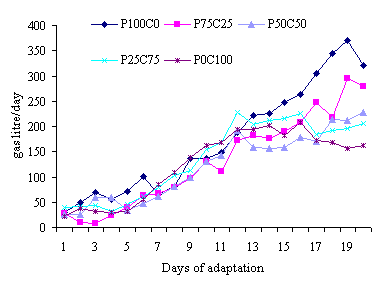| Back to biodigester network |
Optimization of the role of tubular plastic biodigesters in integrated farming systems |
|
|
There will be three experiments and one on-farm activity. The experiments will be conducted in the UTA ecological farm followed by an activity involving farmers in Kandal province. The project is going to be carried out over 2 years (July 2003 to July 2005).
The main objectives of this project are to find out: (i) how to maximize the gas production in tubular plug-flow plastic film biodigesters; (ii) to evaluate supplementation with duckweed and water spinach of fish in ponds charged with biodigestor effluent; (iii) determine response of water spinach to fertilization with biodigester effluent; (iv) measure the impact of this technology with farmers in an integrated approach in which the biogas is used for cooking and the effluent for growing fish and crop or water plants.
There will be close linkages with the NGO Awareness Cambodia that is setting up ecological farms in orphanages for parentless children. The children will benefit by learning how to make best use of the products of the biodigester, namely the gas for cooking and the effluent as fertilizer for vegetables, so that their living standard can be improved.
|
||
| Experiment 1 |
Optimization of gas production in tubular plastic biodigesters by charging with different proportions of pig and cattle manure |
|
| Experimental treatments and design |
The experiment will have five treatments consisting of different proportions of pig and cattle manure (PM and CM) The proportions (fresh basis) between pig and cattle manure are as follows:
The experimental design is a Latin square arrangement of five proportions of manure ratio and five periods each of 30 days. The first 20 days of each period are of adaptation to the new period followed by 10 days of measurements. The experiment will last a total of 150 days, consisting of 5 periods each of 30 days.
The biodigesters are made from tubular plastic film (Internal diameter 0.64m) and will be the same size (2 meters long). Five units will be installed in an area with the same microclimate condition and overall environment. The manure will be put into the biodigester when fresh so that the total amounts of dry matter of manure are the same for each treatment. The amounts of water added will be arranged to give a solids (DM) content fixed at 4% and a charging rate of 2 kg DM/m³ liquid digester volume. The total volume of each biodigester is 0.64 cubic meters. |
|
| Initial results | The pig manure appears to produce almost twice as much gas as
manure from cattle (Figure 1).
Figure 1: Gas production with different proportions of manure from cattle (C) and pigs (P) |
